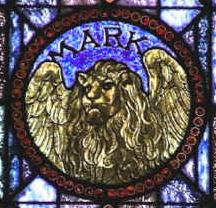Gospel of Mark
Christian Bible Study
Introduction and 35 Lessons
Introduction from the NIV Study Bible
 Author
AuthorAlthough there is no direct internal evidence of authorship, it was the unanimous testimony of the early church that this Gospel was written by John Mark (“John, also called Mark,” Acts 12:12,25; 15:37). The most important evidence comes from Papias (c. a.d. 140), who quotes an even earlier source as saying: (1) Mark was a close associate of Peter, from whom he received the tradition of the things said and done by the Lord; (2) this tradition did not come to Mark as a finished, sequential account of the life of our Lord, but as the preaching of Peter—preaching directed to the needs of the early Christian communities; (3) Mark accurately preserved this material. The conclusion drawn from this tradition is that the Gospel of Mark largely consists of the preaching of Peter arranged and shaped by Mark.
John Mark in the New Testament
It is generally agreed that the Mark who is associated with Peter in the early non-Biblical tradition is also the John Mark of the NT. The first mention of him is in connection with his mother, Mary, who had a house in Jerusalem that served as a meeting place for believers (Acts 12:12). When Paul and Barnabas returned to Antioch from Jerusalem after the famine visit, Mark accompanied them (Acts 12:25). Mark next appears as a “helper” to Paul and Barnabas on their first missionary journey (Acts 13:5), but he deserted them at Perga in Pamphylia to return to Jerusalem (Acts 13:13). Paul must have been deeply disappointed with Mark’s actions on this occasion, because when Barnabas proposed taking Mark on the second journey, Paul flatly refused, a refusal that broke up their working relationship (Acts 15:36–39). Barnabas took Mark, who was his cousin (Col 4:10), and departed for Cyprus. No further mention is made of either of them in the book of Acts. Mark reappears in Paul’s letter to the Colossians written from Rome. Paul sends a greeting from Mark and adds: “You have received instructions about him; if he comes to you, welcome him” (Col 4:10; see Phm 24, written about the same time). At this point Mark was apparently beginning to win his way back into Paul’s confidence. By the end of Paul’s life, Mark had fully regained Paul’s favor (see 2Ti 4:11).
Date of Composition
Some, who hold that Matthew and Luke used Mark as a major source, have suggested that Mark may have been composed in the 50s or early 60s. Others have felt that the content of the Gospel and statements made about Mark by the early church fathers indicate that the book was written shortly before the destruction of Jerusalem in a.d. 70.
Place of Origin
According to early church tradition, Mark was written “in the regions of Italy” (Anti-Marcionite Prologue) or, more specifically, in Rome (Irenaeus; Clement of Alexandria). These same authors closely associate Mark’s writing of the Gospel with the apostle Peter. The above evidence is consistent with (1) the historical probability that Peter was in Rome during the last days of his life and was martyred there, and (2) the Biblical evidence that Mark also was in Rome about the same time and was closely associated with Peter (see 2Ti 4:11; 1Pe 5:13, where the word “Babylon” may be a cryptogram for Rome.)
Recipients
The evidence points to the church at Rome, or at least to Gentile readers. Mark explains Jewish customs (7:2–4; 15:42), translates Aramaic words (3:17; 5:41; 7:11,34; 15:22,34) and seems to have a special interest in persecution and martyrdom (8:34–38; 13:9–13)—subjects of special concern to Roman believers (and to Peter as well; cf. 1 Peter). A Roman destination would explain the almost immediate acceptance of this Gospel and its rapid dissemination.
Occasion and Purpose
Since Mark’s Gospel is traditionally associated with Rome, it may have been occasioned by the persecutions of the Roman church in the period c. a.d. 64–67. The famous fire of Rome in 64—probably set by Nero himself but blamed on Christians—resulted in widespread persecution. Even martyrdom was not unknown among Roman believers. Mark may be writing to prepare his readers for such suffering by placing before them the life of our Lord. There are many references, both explicit and veiled, to suffering and discipleship throughout his Gospel (see 1:12–13; 3:22,30; 8:34–38; 10:30,33–34,45; 13:8–13).
Emphases
- The cross. Both the human cause (12:12; 14:1–2; 15:10) and the divine necessity (8:31; 9:31; 10:33–34) of the cross are emphasized by Mark.
- Discipleship. Special attention should be paid to the passages on discipleship that arise from Jesus’ predictions of his passion (8:34—9:1; 9:35—10:31; 10:42–45).
- The teachings of Jesus. Although Mark records far fewer actual teachings of Jesus than the other Gospel writers, there is a remarkable emphasis on Jesus as teacher. The words “teacher,” “teach” or “teaching,” and “Rabbi” are applied to Jesus in Mark 39 times.
- The Messianic secret. On several occasions Jesus warns his disciples or others to keep silent about who he is or what he has done (see 1:34,44 and notes; 3:12; 5:43; 7:36; 8:30; 9:9).
- Son of God. Although Mark empasizes the humanity of Jesus (see 3:5; 6:6,31,34; 7:34; 8:12; 10:14; 11:12), he does not neglect his deity (see 1:1,11; 3:11; 5:7; 9:7; 12:1–11; 13:32; 15:39).
Mark’s Gospel is a simple, succinct, unadorned, yet vivid account of Jesus’ ministry, emphasizing more what Jesus did than what he said. Mark moves quickly from one episode in Jesus’ life and ministry to another, often using the adverb “immediately” (see note on 1:12). The book as a whole is characterized as “The beginning of the gospel” (1:1). The life, death and resurrection of Christ comprise the “beginning,” of which the apostolic preaching in Acts is the continuation.
Bible Study on Gospel of Mark
I have arbitrarily divided the 16 chapters of Mark into 35 segments for discussion. I have found that in small groups (6 to 20 people) each unit takes about 45 minutes to go through. You can give out the discussion questions the week before or at the time of the study. The discussion questions are slightly different from traditional Bible studies in that they emphasize the application of the book to your life today. Each PDF file has the Scripture Verses (NIV, 1984), Discussion Questions, and Leader's Guide. If you have questions or comments, please use the "Contact Me" button on the menu below. I guarantee that I will read your comments, however, as this web site gets more than 3,000 visitors per day, I can't possibly answer every one.
In response to your requests, these studies are in Adobe PDF format, so they can easily be printed out. If you cannot read PDF files, click to download Adobe Reader.
Some discussion questions are borrowed or adapted from the book New Testament Lesson Maker from NavPress (ISBN 0-89109-688-4). I highly recommend this book, which is available from CBD as well as most large Christian bookstores.
Outline and Lessons
- Introduction to the Gospel of Mark
- Mark 1:1-13 ~ The Beginnings of Jesus’ Ministry (Forerunner, Baptism, Temptation)
- Mark 1:14-28 ~ Jesus’ in Galilee (Call of the first disciples, Early miracles))
- Mark 1:29-45 ~ Preaching and healing in Galilee
- Mark 2:1-17 ~ Capernaum: Healing a paralytic, the calling of Levi
- Mark 2:18-3:6 ~ Fasting, Sabbath controversy
- Mark 3:7-19 ~ Large crowds follow Jesus, Choosing the 12 apostles
- Mark 3:20-35 ~ Jesus and Beelzebub, Teachings in Capernaum
- Mark 4:1-25 ~ Parables of the sower and seeds, kingdom parables
- Mark 4:26-41 ~ Parables of seeds, Calming the Sea of Galilee
- Mark 5:1-20 ~ Healing a demon-possessed man
- Mark 5:21-43 ~ More Galilean miracles (dead girl and sick woman)
- Mark 6:1-29 ~ Unbelief in Jesus’ hometown, Apostles preach and heal in Galilee, John the Baptist beheaded by Herod
- Mark 6:30-56 ~ Jesus feeds the 5,000, Withdraws, and walks on water
- Mark 7:1-23 ~ Lessons of clean and unclean, hypocrites
- Mark 7:24-37 ~ Faith of a Syrophoenician woman, healing of a deaf and mute man
- Mark 8:1-21 ~ Jesus feeds the 4,000, The yeast of the Pharisees and Herod
- Mark 8:22-38 ~ Healing of a blind man, Peter's confession of Christ, Jesus predicts his death
- Mark 9:2-13 ~ The Transfiguration
- Mark 9:14-32 ~ Jesus heals a boy with an evil spirit
- Mark 9:33-50 ~ Who is the greatest?, Who is for us?, Causing others to sin, Saltiness
- Mark 10:1-16 ~ Teaching concerning Divorce, Little children and Jesus)
- Mark 10:17-34 ~ The Rich Young Man, Jesus again predicts his death
- Mark 10:35-52 ~ A Request of James and John, Restoration of Bartimaeus’s Sight
- Mark 11:1-19 ~ The Triumphal Entry, Jusus' Clearing of the Temple
- Mark 11:12-19 ~ Additional discussion questions on Jusus' Clearing of the Temple
- Mark 11:20-33 ~ The withered fig tree, the authority of Jesus is questioned
- Mark 12:1-17 ~ Parable of the Tenants, Paying taxes to Caesar
- Mark 12:18-44 ~ Marriage in Heaven, The greatest commandment(s), Whose son is the Christ?, Widow's offering
- Mark 13:1-37 ~ Signs of the End of the Age, the day and hour unknown
- Mark 14:1-31 ~ The Anointing of Jesus, the Lord's Supper, Jesus predicts Peter's denial
- Mark 14:32-52 ~ Praying in Gethsemane, Jesus arrested
- Mark 14:53-72 ~ Before the Sanhedrin, Peter disowns Jesus
- Mark 15:1-20 ~ Jesus before Pilate, the soldiers mock Jesus
- Mark 15:21-47 ~ The Crucifixon, the death of Jesus, the burial
- Mark 16:1-20 ~ The Resurrection of Jesus, concluding verses
| Click here for Complete Menu of Bible Studies and Christian Resources |
| Jokes, Funny Cats | Meet Dave Ahl | Cool Links | Christian Investing | Contact Me |
 |
|
|
|

|